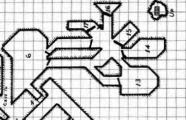So often it happens that I'm working on one thing, and in the process get pulled down a rabbit hole that leads to a treasure all its own.
In this case, a paragraph in the First Fantasy Campaign's section on INTERNAL IMPROVEMENTS (pages 10-14, '77 print) on Ship Building leads to this post and will form the basis of some ship combat rules I'm preparing to playtest at the COUNCIL CON 2024.
Arneson's entry contains interesting but incomplete information, intended to be used in conjunction with the Naval Combat rules in OD&D. One wonders however, if Arneson has in mind the rules as he submitted them instead of the rules as Gygax edited them for publication.
Be that as it may, the paragraph tells us that a shipbuilding port must build at least 24 hull points a year and cannot build more than 80 hull points worth of ship(s) in one year. That's an interesting range, but lets move on.
He then gives rates of construction based on green, seasoned, and aged wood and how long ships built of these will last.
Next, a crucial bit of information, "1 hull point is about 600 logs."
Later in the price list we are given a list of ship types and what each costs. We are NOT told the hull point value of these ship.
One might think you could go to OD&D and look that up, but you'd be wrong. Firstly most of the ships (not all) listed in OD&D are different from those in the FFC, but worse, the OD&D rules don't give hull point values either.
In the 3lbb's, almost as an afterthought under the Missiles heading of the Naval section (Vol III:28-30) is this:
"Large ships have from 18-24 points of possible damage before sinking, small ships have from 9-15, and a boat but 3 points. "
So if we wanted to use the other ships in the FFC in a game, or you really just wanted to get more specific with the OD&D ship types, or you are adding a new type of your own, what hull points should a given ship have?
Initially I thought this would be an obvious calculation. In the price list, Arneson tells us that ten logs cost 1 gold piece. Knowing the costs of the ships already and that 600 logs = 1 hull point should allow us to calculate the hull points, right?
Nope. Not at all. To begin, it is unclear if that log cost is for green, aged, or seasoned logs, which will affect how long it takes to build the ship and how many can be built in a year, which must exceed at least 24 points. Regardless of that problem the math doesn't work out for the Hull Point ranges we were expecting from OD&D.
In the FFC ship prices range from 5000gp to 40000 gp. For example, in the FFC a Longboat cost 24,000 gp. Theoretically then at a cost of 1gp per ten logs it should take 2400 logs. At 1 hull point per 600 logs that is a measly 4 hull points! Cheaper ships, like a small Galley have even less.
Okay we have to assume the log price was for cheap lumber and firewood - not the quality logs needed for ships.
Luckily, Arneson gave us another clue. In the pricelist a simple boat only costs 400 gp and in parentheses "(120 logs)". Bingo. That gives us the cost conversion figure we need. If 120 logs = 400gp expense, then 600 logs = 2000 gp worth of ship cost. (600/120 = 5; 5 x 400 = 2000).
Going back to our Longship at a cost of 24,000 gp, it will have a hull point value of 12 and that makes way more sense. The most expensive ship in the FFC, a large galley at 40000 gp has 20 hull points.
Now, this system does require an awful lot of logs to build a ship, way more than is historically accurate, but we can assume that "log cost" is also factoring in other construction expenses and isn't a true log count. I'm not sure many Gamemasters are going to be tracking logs and forests etc. anyway, but if you were to do that, I'd recommend dividing by a factor of 10 ("600 logs" equals 60 actual logs).
In any case it is now possible to calculate the cost of any given ship by its hull points, or conversely to calculate the OD&D hull points of a ship by its cost.
1 Hull Point = 2000 gp.





